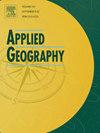Spatial agglomeration patterns and co-agglomeration rules of agribusiness: From the perspective of industrial chain
IF 4
2区 地球科学
Q1 GEOGRAPHY
引用次数: 0
Abstract
The industrial spatial layout of agribusiness profoundly influences the modernisation transformation of agriculture in the post-industrial era. This study employs hot spot analysis and the density-based spatial clustering of applications with noise (DBSCAN) algorithm to investigate the spatial agglomeration patterns of agribusiness, then utilises co-location quotient and Apriori data mining algorithm to explore the spatial co-agglomeration rules of agribusiness. The results show that: (1) The Yangtze River Delta urban agglomeration forms a multi-centre, misaligned development pattern, along with a relatively specialised geographical division of labour at different stages of the agribusiness industrial chain, creating a hierarchical spatial structure of clusters. (2) The related industries within the agribusiness industrial chain present vertical integration paths with backward linkage characteristics, which strengthens the market dominance of the back-end industries. The distance between different industries within the agribusiness industrial chain constrains their spatial co-agglomeration. (3) Different cities have formed directional and heterogeneous rules of spatial co-agglomeration, leading to the emergence of four spatial co-agglomeration modes between agribusiness subdivision industries: the dual-engine mode driven by technology and market, the deeply integrated industrial chain mode, the market demand-driven mode, and the technology innovation-empowered mode.

农业综合企业空间集聚模式与共集聚规律——基于产业链视角
农业综合企业的产业空间布局深刻影响着后工业时代农业的现代化转型。本研究采用热点分析和基于密度的带噪声应用空间聚类(DBSCAN)算法研究农业综合企业的空间集聚模式,然后利用共位商和Apriori数据挖掘算法探索农业综合企业的空间共集聚规律。研究结果表明:①长三角城市群形成了多中心、错位的发展格局,在农商产业链的不同阶段形成了相对专业化的地域分工,形成了层次分明的集群空间结构;(2)农商产业链内相关产业呈现出纵向整合路径,具有后向联动特征,强化了后端产业的市场主导地位。农商产业链内不同产业间的距离制约了其空间共集聚。③不同城市形成了方向性、异质性的空间共集聚规律,导致农商细分产业间出现了技术与市场双引擎驱动模式、产业链深度融合模式、市场需求驱动模式和技术创新驱动模式四种空间共集聚模式。
本文章由计算机程序翻译,如有差异,请以英文原文为准。
求助全文
约1分钟内获得全文
求助全文
来源期刊

Applied Geography
GEOGRAPHY-
CiteScore
8.00
自引率
2.00%
发文量
134
期刊介绍:
Applied Geography is a journal devoted to the publication of research which utilizes geographic approaches (human, physical, nature-society and GIScience) to resolve human problems that have a spatial dimension. These problems may be related to the assessment, management and allocation of the world physical and/or human resources. The underlying rationale of the journal is that only through a clear understanding of the relevant societal, physical, and coupled natural-humans systems can we resolve such problems. Papers are invited on any theme involving the application of geographical theory and methodology in the resolution of human problems.
 求助内容:
求助内容: 应助结果提醒方式:
应助结果提醒方式:


